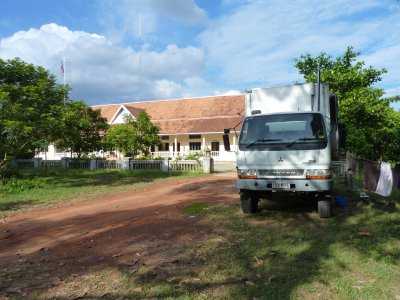
Camp was outside the Tourist Police headquarters.
Lots of long talks with them. And a couple of visitors from the nearby University campus.
We've met a lot of marketing students. Not sure that bodes well for the country.
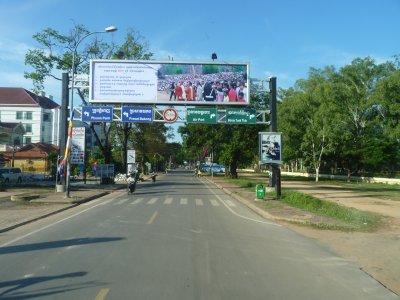
We haven't figured out the difference between green and blue, though we think green is for the bigger places.
They bear no relation to lanes.
The road to Phnom Penh from Siem Reap involves a right turn, somewhere in the next 500m or so. We think!
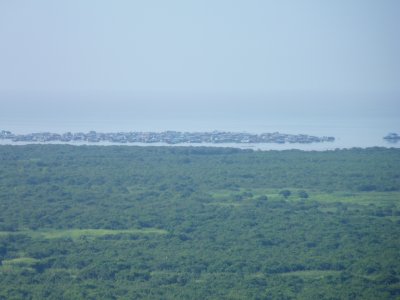
Cambodia is interesting in that the central fertile plain surrounds a large lake.
The river Sap joins the Mekong somewhere a bit North of Phnom Penh. During the rainy season the flow is from the Mekong into the lake. Rice growing country.
The island in this picture is a floating village.

A sandstone hill, with, you guessed it, an old temple on top.
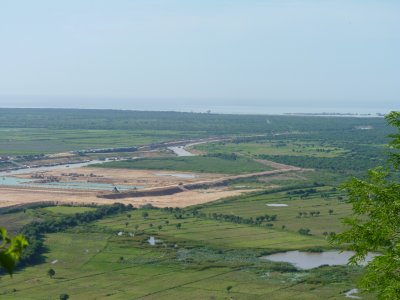
A private company with a concession. They wanted to charge us US$2 each "entry fee" to drive along the road to the lake.
We declined the offer.
The other offer was of US$30 for a boat ride to the floating village. Even the marketing man who had followed us down the road on motorbike to send us back to the ticket office thought that was a bit high.
The port provides one way of traveling from Siem Reap to Phnom Penh. Numerous ferries available.
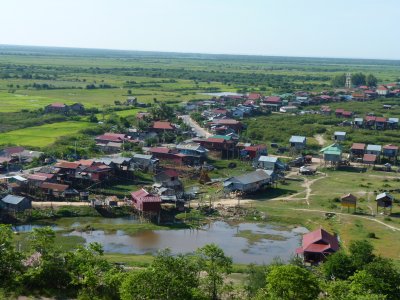
Lots of houses on stilts and a fair amount of house building.
Builders must be the same the world over. We could hear the music from the top of the hill.

A broken truck.
The warning branch in the road evoked memories of Zambia from 35 years ago. I slowed automatically while working out what was happening.
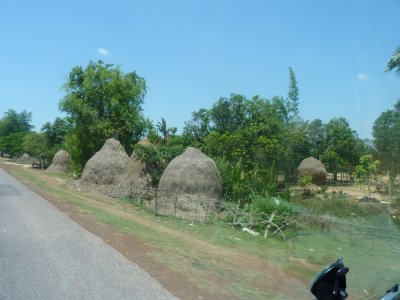
Some were raised off the ground. Most had some sort of pipe (bamboo) up the center.
We figured they would set themselves alight if there was no ventilation.
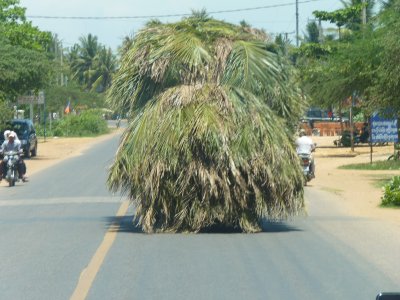
Now imagine the difficulty of overtaking with a right hand drive vehicle driving on the right hand side of the road.
"is it ok to overtake?" - "yes" - "are you sure?" - "well almost, but I can't see....".
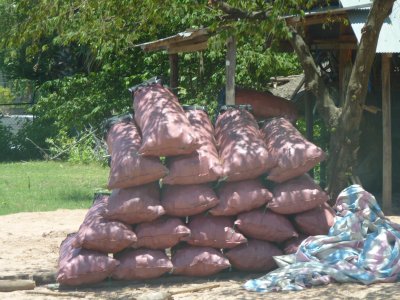
Its in quite substantial (75mm diameter) pieces.

Very little English spoken. Big laughs when the menu was finally produced and it was all in Khmer.
We had some fried rice with beef and an egg on top.
We couldn't work out the price but it all sounded reasonable. We paid what we thought we'd agreed.
About 10 min later one of the children arrived with our change.
It was one of those occasions when, for whatever reason, we felt we could trust the people.
Much laughter and smiles. And they also understood when to leave, which can be a problem sometimes in any country.
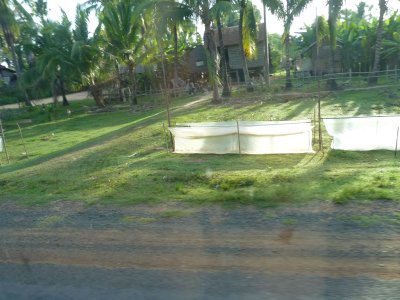
These vertical plastic sheets above plastic sheet troughs seemed to collect quite a lot. Some of them had about 25mm in the trough.
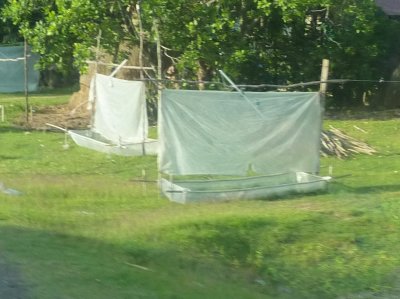
I haven't built one. We've been relying on collecting rain water and seem to be just about keeping up.
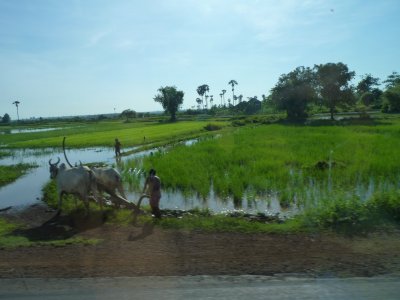
Ploughing a rice field with oxen.
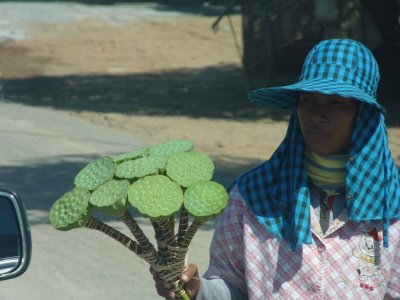
At Udong was the first time we saw them sold on sticks at the traffic lights.
We still don't know what they are.
Edit:- thanks to Alan and Sharon ... they are lotus seed heads. Edible. Have to do a bit of reading methinks.
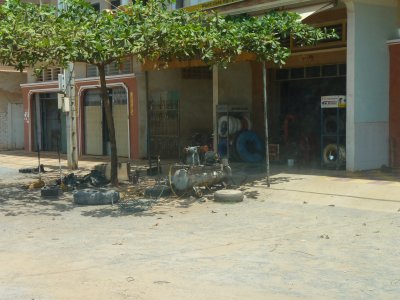
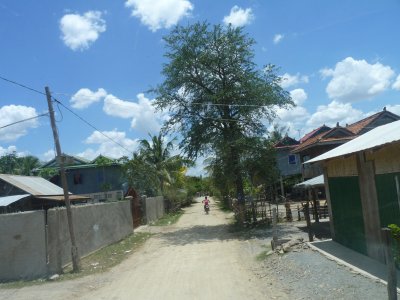
Our map showed a route through the mountains to the coast.
The young guy on the motorbike was our guide showing us the road.
We'd stopped at a petrol station to ask and he volunteered.
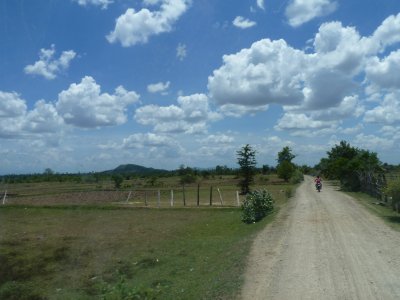
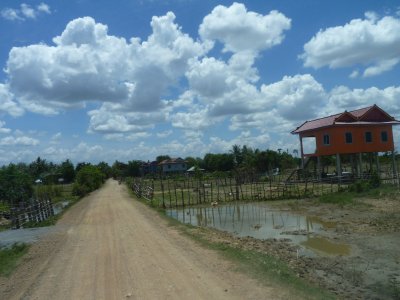
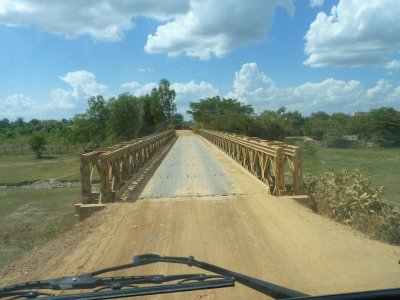
Alas we failed. We drove in a circle and ended back on route 4.
On the third attempt we figured we'd hit the jackpot. A bailey bridge over a small river was enough to convince us.
Further on we used the gps to give us a lat/long which we gave to googlemaps. We were indeed on "Route 44", at least as far as google was concerned!
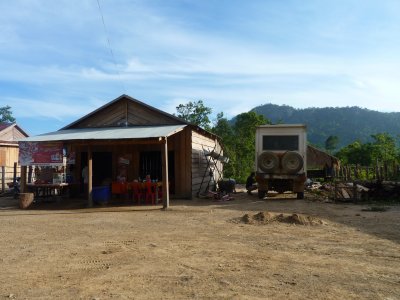
The truck was again given the once over by the men of the household.
Food was provided after a phone call to a brother in Siam Reap who translated.
Being a pub there was loud music. It looked like a DVD of Chinese love songs. Fortunately stopped about 9pm.
Electricity was by generator.
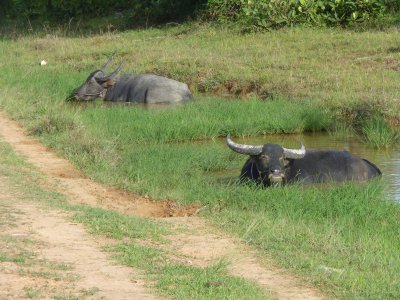
Our hosts had been very definite that there wasn't a way through the mountains.
The road on Google maps stopped as well. And there seemed to be a missing 20km section of road on the satellite view.
Maybe we should cool off like these beasts.
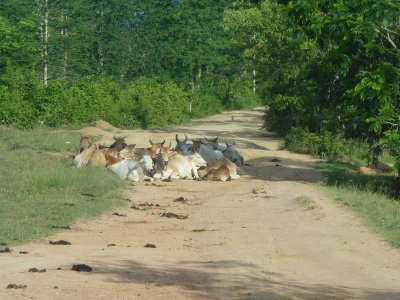
For no apparent reason than that the road was wide enough.
A pity as the satellite image showed an interesting looking limestone pavement area about 10km beyond where the road looked like it stopped.
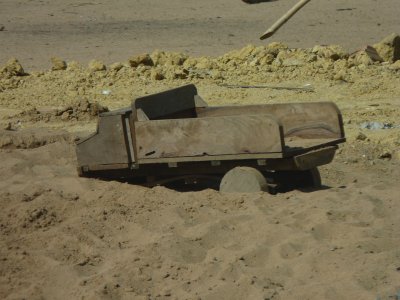
We found one and thought we'd better ask.
While Ali asked I spotted this toy truck abandoned in the sand of a building site.
Some things are the same the world over.
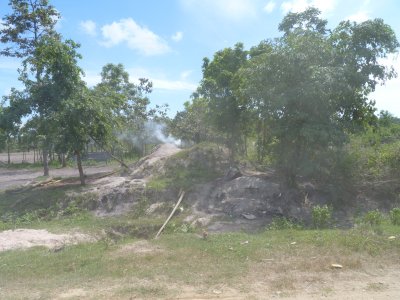
This was the only sign of a kiln we saw.
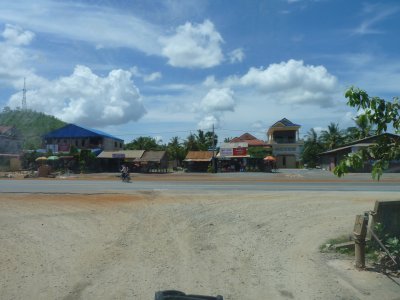
The dirt road had been really rough and taken its toll. We are very tired and a bit scratchy.
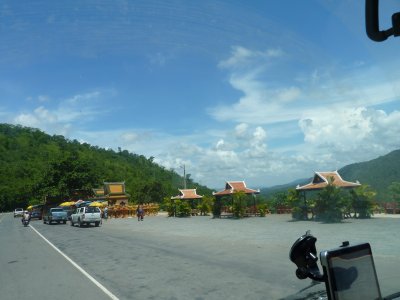
There was a sign that said there was one, but quite a distance before this (as is common with the signs).
Its the only one we've seen.
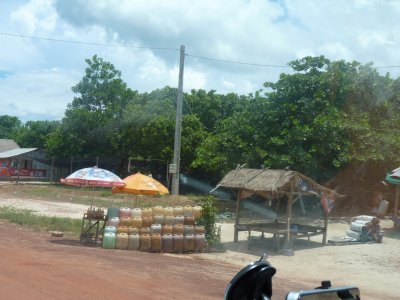
There are real ones, most look built in the last few years, but this has novelty value.
A word on buying diesel. Its easier than we thought so far.
Pump prices are displayed (US$ in Cambodia) and there's someone there to operate the pump.
Its been similar in all three countries so far. Thailand was a bit iffy the first time until we figured out it was called dsel (pronounced dee cell).
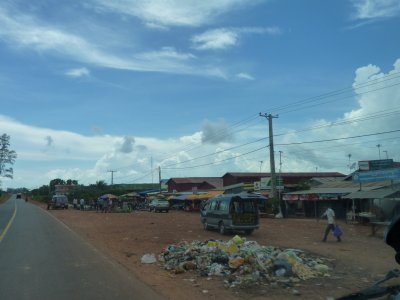
Like lots of tropical countries there's lots of rubbish. Hopefully waiting to be picked up.
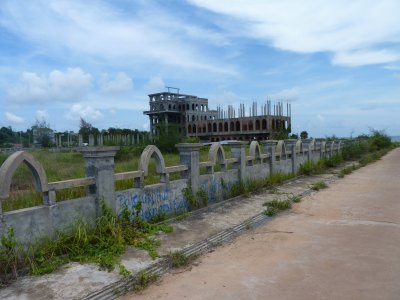
This development was probably abandoned during Pol Pot's era.
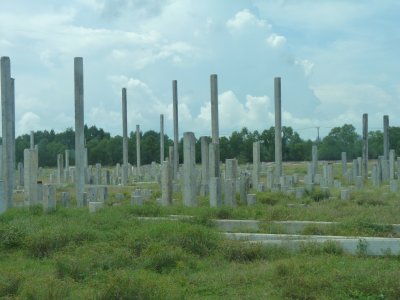
Some sort of bizarre caricature of stonehenge, waiting for a future archeologist to interpret the meaning. Also an abandoned development.
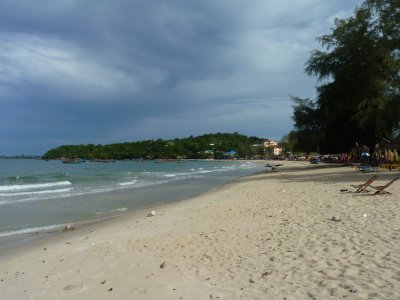
However, behind the restaurant strip, where we parked for the night, was decidedly seedy looking. Discarded plastic and litter everywhere.
The area seemed to be a haunt for Westerners frequenting the bars and restaurants. That also added to the seedy feeling. Not our scene I guess.
The food was Khmer but none of the spicyness we've become used to so we suspect its been westernised.
We were also tired so perhaps not of a mood to relax and enjoy. Perhaps the 1000 riel (about 25 cents) for the (clean) loo and $1 for parking grated a bit as well. It added to the feeling that everyone had their hand out.
We moved on after one night.
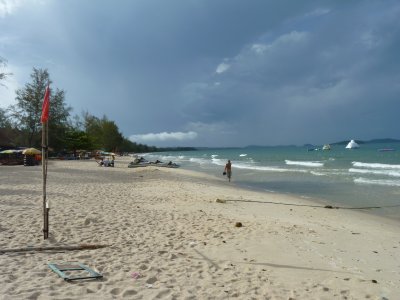
We also found a supermarket on the way out. The sort of place that we felt targets expatriates, with appropriate prices. Not too bad though, we stocked up with "tide us over" things and bread.
We are still searching for dried milk. In Thailand it was flavoured with vanilla for kids. There was also lots of non-dairy crema. Haven't found dried milk in Cambodia, though there is that long life UHT stuff.
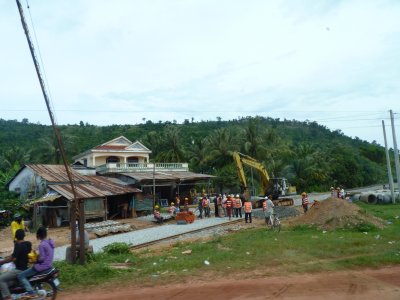
Lots of activity though. It looks like its being completely rebuilt. Lots of concrete sleepers ready to be laid. We didn't see many lines but there were some being laid here, on new ballast.
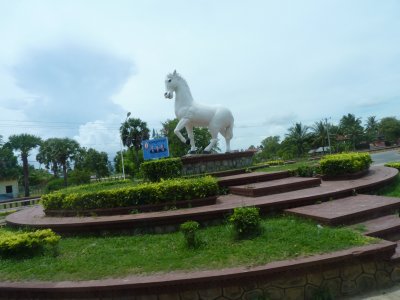
At one point we missed the "no trucks" sign and brushed a few overhead wires. Also found ourselves at the old railway bridge, used as a road bridge, having to find our way to the new road bridge.
Ali asked at the tourist information office we happened to spot.
The conversation was mostly in French. Something along the lines of "go straight down that road for 25km then turn right at the white house".
Somewhere around the 16km mark was this white horse in the middle of a roundabout so we hung a right. Such are the vagaries of language and communication.
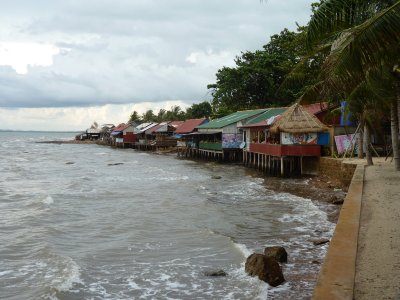
This is restaurant row. The fresh fish is kept in baskets in the sea.

We won't go looking for it but it seems the local petrol station became a mass grave.
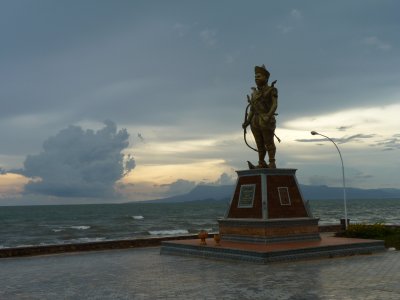
He also gave the same answer to someone who asked what sort of fish a local fisherman had caught in his net.
He's facing towards the Vietnamese border.
Sihanoukville is on the other side of those hills in the distance. There's a national park, an old hill station, but the road up the hill was closed for construction.